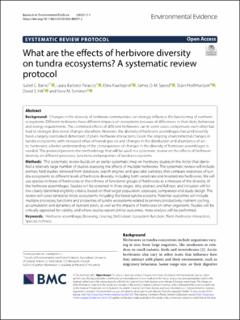| dc.description.abstract | Background
Changes in the diversity of herbivore communities can strongly influence the functioning of northern ecosystems. Different herbivores have different impacts on ecosystems because of differences in their diets, behaviour and energy requirements. The combined effects of different herbivores can in some cases compensate each other but lead to stronger directional changes elsewhere. However, the diversity of herbivore assemblages has until recently been a largely overlooked dimension of plant–herbivore interactions. Given the ongoing environmental changes in tundra ecosystems, with increased influx of boreal species and changes in the distribution and abundance of arctic herbivores, a better understanding of the consequences of changes in the diversity of herbivore assemblages is needed. This protocol presents the methodology that will be used in a systematic review on the effects of herbivore diversity on different processes, functions and properties of tundra ecosystems.
Methods
This systematic review builds on an earlier systematic map on herbivory studies in the Arctic that identified a relatively large number of studies assessing the effects of multiple herbivores. The systematic review will include primary field studies retrieved from databases, search engines and specialist websites, that compare responses of tundra ecosystems to different levels of herbivore diversity, including both vertebrate and invertebrate herbivores. We will use species richness of herbivores or the richness of functional groups of herbivores as a measure of the diversity of the herbivore assemblages. Studies will be screened in three stages: title, abstract and full text, and inclusion will follow clearly identified eligibility criteria, based on their target population, exposure, comparator and study design. The review will cover terrestrial Arctic ecosystems including the forest-tundra ecotone. Potential outcomes will include multiple processes, functions and properties of tundra ecosystems related to primary productivity, nutrient cycling, accumulation and dynamics of nutrient pools, as well as the impacts of herbivores on other organisms. Studies will be critically appraised for validity, and where studies report similar outcomes, meta-analysis will be performed.
Background
Herbivores in tundra ecosystems include organisms varying in size, from large ungulates, like muskoxen or reindeer, to small rodents, birds and invertebrates [1]. Arctic herbivores also vary in other traits that influence how they interact with plants and their environment, such as migratory behaviour, home range size, or their digestive physiology [2]. Given these differences, the diet choices and energy requirements of herbivores differ strongly [3, 4] and so do their impacts on ecosystems. Further, the effects of herbivores on processes, functions and properties of tundra ecosystems can be direct or indirect. For example, trampling by large herbivores can influence soil structure and soil biota directly, but also indirectly through changes in plant abundance and community composition [5]. To add to this complexity, the combined effects of different herbivore assemblages can lead to opposite outcomes (Fig. 1a). For example, in some cases the combined effects of large and small mammalian herbivores on vegetation are stronger than would be predicted for each group of herbivores alone [6,7,8]. In other cases, the effects of different herbivores can compensate each other if herbivores consume different plant species, leading to little to no changes in plant community composition [3, 9]. However, herbivore diversity has until recently been a largely overlooked dimension of plant–herbivore interactions in tundra ecosystems [10, 11], and we know little about how functionally different herbivore assemblages will affect these systems. | en_US |

